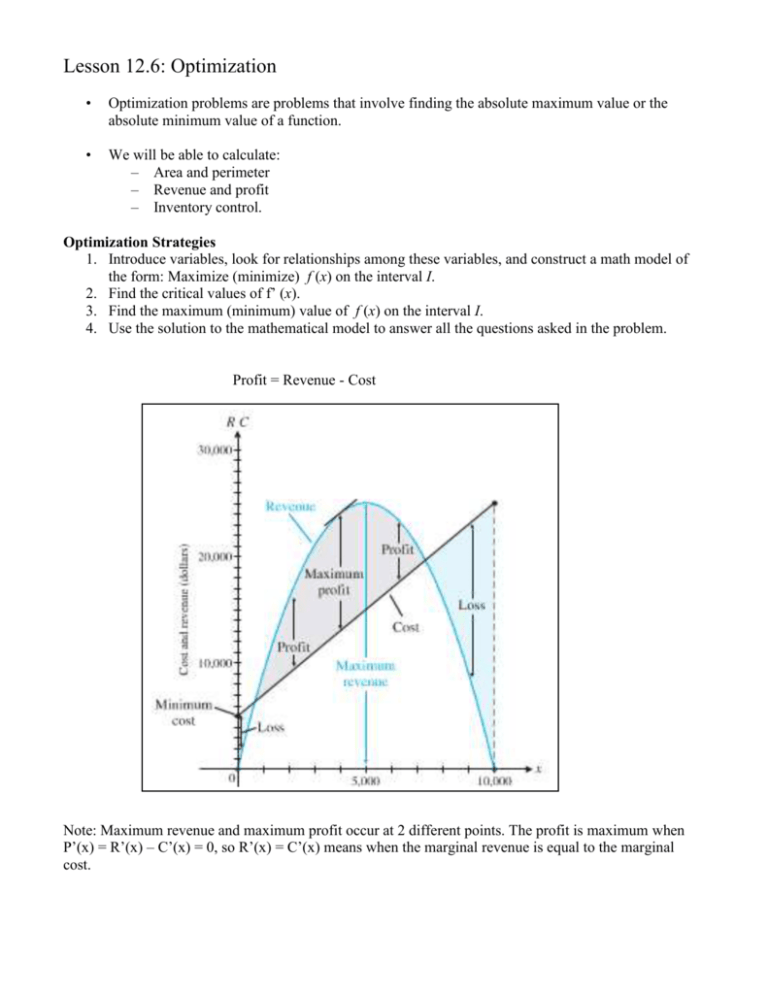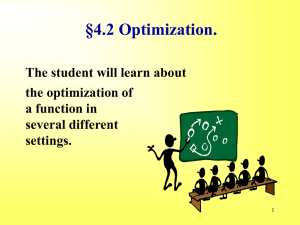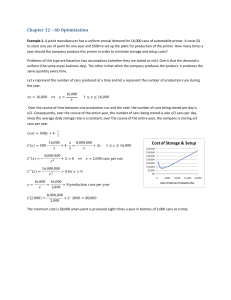Lesson 12.6: Optimization
advertisement

Lesson 12.6: Optimization • Optimization problems are problems that involve finding the absolute maximum value or the absolute minimum value of a function. • We will be able to calculate: – Area and perimeter – Revenue and profit – Inventory control. Optimization Strategies 1. Introduce variables, look for relationships among these variables, and construct a math model of the form: Maximize (minimize) f (x) on the interval I. 2. Find the critical values of f’ (x). 3. Find the maximum (minimum) value of f (x) on the interval I. 4. Use the solution to the mathematical model to answer all the questions asked in the problem. Profit = Revenue - Cost Note: Maximum revenue and maximum profit occur at 2 different points. The profit is maximum when P’(x) = R’(x) – C’(x) = 0, so R’(x) = C’(x) means when the marginal revenue is equal to the marginal cost. 1) Problem 1 A homeowner has $320 to spend on building a fence around a rectangular garden. Three sides of the fence will be constructed with wire fencing at a cost of $2 per linear foot. In order to provide a view block for a neighbor, the fourth side is to be constructed with wood fencing at a cost of $8 per linear foot. Find the dimensions and the area of the largest garden that can be enclosed with $320 worth of fencing. Step 1: Analyze the problem to set up the variables and equations. The problem asks to find the dimensions, so let x = length and y = width This problem has to do with the area so A = xy The cost equation for fencing this garden is: C = 8x + 2y + 2x + 2y = 10x + 4y = 320 The problem asks to find the dimensions and the area of the largest garden that can be enclosed with $320 worth of fencing. This means we need to maximize the area A = xy subject to 10x + 4y = 320 Solve for one variable: 10x + 4y = 320 4y = -10x + 320 5 x 80 y= 2 Since A = xy 5 5 2 x 80 x 80 x So A = x 2 2 We need to maximize A Step 2: Find the critical value First, find the domain of A(x) We know for sure that the dimensions can not be negative 5 x 80 ≥ 0 x ≥ 0 and 2 5 x ≥ -80 2 -5x ≥ -160 x ≤ 32 So the domain is: 0 ≤ x ≤ 32 or [0,32] Find A’(x) = -5x + 80 = 0 -5x = -80 x = 16 Since 16 is in the domain of A(x) so 16 is the only critical value for this function. Step 3: We have a closed interval [0,32] so check these 2 endpoints and the critical value A(0) = 0 A(16) = 640 A(32) = 0 At x = 16, we have an absolute maximum Step 4: Use the solution to answer all the questions asked in the problem 5 (16) 80 = 40 Length x = 16, so width y = 2 The dimensions of the garden with the maximum area of 640 square feet are 16 feet by 40 feet with the 16-foot side with wood fencing. 2) Problem 2 The homeowner decides to build a fence for a rectangular area. Three sides of the fence will be constructed with wire fencing at a cost of $2 per linear foot. The fourth side is to be constructed with wood fencing at a cost of $6 per linear foot. What is the minimum cost of building a fence that will enclose a garden with area 1800 square feet? What are the dimensions of this garden? Step 1: Analyze the problem to set up the variables and equations. The problem asks to find the dimensions, so let x = length and y = width This problem has to do with the area so A = xy The cost equation for fencing this garden is: C = 6x + 2y + 2x + 2y = 8x + 4y The problem asks to find the minimum cost of building the fence that will enclose a garden with area of 1800 square feet. This means we need to minimize the cost C = 8x + 4y subject to A = xy = 1800 Solve for one variable: xy = 1800 so y = 1800/x C(x) = 8x + 4y 7200 1800 C(x) = 8 x 4 We need to minimize C 8x x x Step 2: Find the critical value Since x and y represent distances, we know that x > 0 and y > 0 (neither variable can equal 0 because their product must be 1800). Thus the domain is (0,∞) 7200 C’(x) = 8 7200 x 2 8 2 = 0 x 7200 8 x2 8 x 2 7200 x 2 900 x = -30 or x = 30 The only critical value is x = 30 (-30 is not in the domain) Step 3: We have an open interval (0,∞) so apply the 2nd derivative test to find out the absolute extrema C’(x) = 8 7200 x 2 C’’(x) = 14400x-3 = 14400 x3 14400 >0 30 3 Since we only have 1 critical value and C’’>0, therefore, at x=30, we have an absolute minimum value. C’’(30) = Step 4: Use the solution to answer all the questions asked in the problem x=30, y = 1800/x = 60 C(30) = 8 x 7200 7200 8(30) 240 240 480 x 30 The minimal cost for enclosing a 1800 square foot garden is $480 and the dimensions are 30 feet by 60 feet with the 30-foot side with wood fencing. 3) Problem 3 An office supply company sells x heavy duty paper shredders per year at $p per shredder. The price-demand equation for these shredders is p = 300 – x/30. What price should the company charge for these shredders to maximize its revenue? What is the maximum revenue? Recall that Revenue = price * demand R = px x x2 R = 300 x 300 x 30 30 Both price and demand must be nonnegative x ≥ 0 and p ≥ 0 300 – x/30 ≥ 0 9000 – x ≥ 0 (multiply both sides by 30) x ≤ 9000 Domain is [0, 9000] Find critical value x R’(x) = 300 0 15 x 300 0 15 4500 – x = 0 (multiply both side by 15) x = 4500 is a critical value 1 <0 15 So we have an absolute maximum at x = 4500 x2 4500 2 300(4500) 675000 R(4500) = 300 x 30 30 R’’(x) = p = 300 – x/30 = 300 – 4500/30 = 300 – 150 = 150 Therefore, at the demand x = 4500 units, and the price is $150 per shredder, the company will have a maximum revenue of $675,000 4) Problem 4 The annual cost of manufacturing x paper shredders for the office supply company in Matched Problem 3 is C(x) = 90000 + 30x.. What is the company’s maximum profit? What should it charge for each shredder, and how many shredders should it produce? We will use revenue equation found from Matched problem 3 x x2 R(x) = 300 x 300 x 30 30 Profit = Revenue – Cost x2 x2 P(x) = 300 x 90000 30 x 270 x 90000 30 30 The domain is the same as in Matched Problem 3: [0, 9000] x 270 0 15 -x + 4050 = 0 x = 4050 is a critical value P’(x) = 1 < 0 absolute maximum 15 x2 4050 2 270 x 90000 270(4050) 90000 456750 P(4050) = 30 30 P’’(x) = p = 300 – x/30 = 300 – 4050/30 = 300 – 135 = 165 Therefore, the company will receive a maximum profit of $456,750 when 4050 paper shredders are manufactured annually and sold for $165 each. 5) Problem 5 The government has decided to tax the office supply company in Matched Problem 4 $20 for each shredder produced. Taking into account this additional cost, how many shredders should the company manufacture each week to maximize its weekly profit? What is the maximum weekly profit? How much should the company charge for the shredders to realize the maximum weekly profit? The tax of $20 per unit changes the company’s cost equation so instead of C(x) = 90000 + 30x, we now have C(x) = C(x) = 90000 + 50x. (20 dollars are added to the variable cost, not fixed cost) P(x) = R(x) – C(x) = 300 x x2 x2 90000 50 x 250 x 90000 30 30 The domain is the same as the previous problem [0, 9000] x 250 0 15 -x + 3750 = 0 x = 3750 is a critical value P’(x) = 1 < 0 absolute maximum at x = 3750 15 x2 3750 2 P(3750) = 250 x 90000 250(3750) 90000 378750 30 30 P’’(x) = p = 300 – x/30 = 300 – 3750/30 = 300 – 125 = 175 Therefore, the company will receive a maximum profit of $378,750 when 3750 paper shredders are manufactured annually and sold for $175 each. 6) Problem 6 A walnut grower estimates from past records that if 20 trees are planted per acre, each tree will average 60 pounds of nuts per year. If for each additional tree planted per acre the average yield per tree drops 2 pounds, how many trees should be planted to maximize the yield per acre? What is the maximum yield? Let x = the number of additional trees planted per acre. 20 + x = total number of trees per acre 60 – 2x = yield per tree F(x) = yield per acre = total number of trees x yield per tree = (20+x)(60-2x) We need to maximize f(x) = (20+x)(60-2x) = -2x2 + 20x + 1200 Find the domain: x ≥ 0 (the number of additional tree can not be negative), so 20 + x ≥ 0 Also, 60 – 2x ≥ 0 (yield per tree can not be negative) -2x ≥ -60, x ≤ 30 Thus, the domain is: [0,30] Find critical value: F’(x) = -4x + 20 = 0 -4x = -20, x= 5 is a critical value F’’(x) = -4 < 0 absolute maximum at x = 5 F(5) = -2x2 + 20x + 1200 = -2 (5)2 + 20(5) + 1200 =1250 Therefore, a grower will receive a maximum yield of 1250 pounds of nuts per acre if 5 trees are planted per acre. 7) Problem 7 After further analysis, the walnut grower in the last Matched Problem determines that each additional tree planted will reduce the average yield by 4 pounds. All other information remains the same. How many additional trees per acre should the grower plant now in order to maximize the yield? What is the new maximum yield? Let x = the number of additional trees planted per acre. 20 + x = total number of trees per acre 60 – 4x = yield per tree F(x) = yield per acre = total number of trees x yield per tree = (20+x)(60-4x) We need to maximize f(x) = (20+x)(60-4x) = -4x2 - 20x + 1200 Find the domain: x ≥ 0 (the number of additional tree can not be negative), so 20 + x ≥ 0 Also, 60 – 4x ≥ 0 (yield per tree can not be negative) -4x ≥ -60, x ≤ 15 Thus, the domain is: [0,15] Find critical value: F’(x) = -8x - 20 = 0 -8x = 20, x= -5/2 is not a critical value However, we do have a closed interval [0,15], so to find the absolute maximum, we can determine the value of the endpoints F(0) = 1200 F(15) = 0 F(5) = -2x2 + 20x + 1200 = -2 (5)2 + 20(5) + 1200 =1250 Therefore, a grower will receive a maximum yield of 1200 pounds of nuts per acre if no additional trees are planted. 8) Problem 8 A recording company anticipates that there will be a demand for 20000 copies of a certain compact disk (CD) during the following year. It costs the company $.40 to store a CD for one year. Each time it must make additional CDs, it costs $250 to set up the equipment. How many CDs should the company make during each production run to minimize its total storage and setup costs? This is an example of an inventory control problem. One of the basic assumptions made in these problems is that the demand is uniform – i.e. if there are 250 working days in a year, then the daily demand would be 20000 ÷ 250 = 80CDs. The company could decide to produce all 20000 CDs at the beginning of the year. This would minimize the set-up costs, but would result in the very large storage costs. At the other extreme, it could produce 80 CDs each day. This would minimize the storage costs, but would result in very large set-up costs. Some where in between these two extremes is the optimal solution that will minimize the total storage and set-up costs. Let x = number of CDs manufactured during each production run Let y = number of production runs Assume that the demand is uniform, then the number of CDs in storage between production runs will decrease from x to 0, and the average number of CDs in storage each day is x/2 It costs $.40 to store a CD for one year, the total storage cost is .40(x/2) = .20x Total cost = set-up cost + storage cost Total cost C(x) = 250y + .20x We need to find a relationship between x and y. If the company produces x CDs in each of y production runs, then the total number of CDs produced is xy. So we have: xy = 20,000 y = 20000/x The number of CDs must be at least 1 and less than 20,000 so the domain is [1,20000] C(x) = 250y + .20x = 250 (20000/x) + .20x = 5000000 .2 x x We want to minimize the cost so first find the critical value: C’(x) = 5000000 .2 0 x2 5000000 .2 x2 5000000 .2 x 2 x2 = 25,000,000 so x = 5000 or -5000 Only 5000 is the critical value because it’s in the domain of C(x) 10,000,000 x3 10,000,000 C’’(5000) = >0 absolute minimum at x = 5000 5000 3 C’’(x) = C(5000) = 5000000 5000000 .2 x = .2(5000) =2000 x 5000 y = 20000/x = 20000/5000 = 4 Therefore, the company can minimize its total cost by making 500 CDs fours times during the year.







